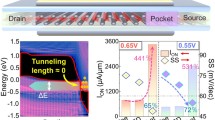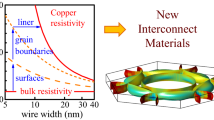Abstract
The quantum transport through Tour Wires (TWs) functionalized with different side groups was studied using nonequilibrium Green’s function formalism combined with extended Huckel theory. Au–TW–Au junctions were constructed with functional groups \(\hbox {NO}_{2}\) and \(\hbox {NH}_{2}\). The transmission spectrum and the isosurface of transmission eigen channel at the HOMO resonance and the LUMO resonance shows that the resonant transmission peaks are related to the delocalized nature of the \(\pi \)-orbitals of the TWs that was not much affected by the functionalization at room temperature. Furthermore, the influence of the temperature effect on the transport characteristics have been emphasized, and the result shows that for the TW and TW–\(\hbox {NH}_{2}\) systems conductance increase with increasing temperature indicating the dominating transport mechanism which is due to thermionic emission. The temperature dependence arises from the thermal spreading in the leads but also from a thermal average over the different configurations. In particular, negative differential resistance nature was observed for TW–\(\hbox {NO}_{2}\) at the temperature of 100 K in the positive and the negative bias region.






Similar content being viewed by others
References
Joachim, C., Gimzewski, J.K., Aviram, A.: Electronics using hybrid-molecular and mono molecular devices. Nature (London) 408, 541–548 (2000)
Donhauser, Z.J., Mantooth, B.A., Kelly, K.F., Bumm, A., Monnell, J.D., Stapleton, J.J., Rawlett, A.M., Tour, J.M., Weis, P.S.: Conducting switching in single molecule through conformational changes. Science 292, 2303–2307 (2001)
Reed, M.A., Chen, J., Rawlett, A.M., Price, D.W., Tour, J.M.: Molecular random access memory. Appl. Phys. Lett. 78, 3735–3737 (2001)
Tour, J.M.: Electronics, synthesis and testing of components. Acc. Chem. Res. 33, 791–804 (2000)
Andrews, Q.D., Richard, R.C., Van Duyne, P., Ratner, M.A.: Single molecules electron transport junctions: charging and geometric effects on conductance. Chem. Phys. 125, 174718–174718-9 (2006)
Kergueris, C., Bourgoin, J.P., Esteve, D., Urbina, C., Magoga, M., Joachim, C.: Electron transport through a metal–molecule–metal junction. Phys. Rev. B. 59, 12505–12513 (1999)
Hall, L.E., Reimers, J.R., Noel, S., Hush, N.S., Silvebrook, K.: Formalism, analytical model and a priori-Green’s function-based calculations of the current–voltage characteristics of molecular wires. J. Chem. Phys. 112, 1510–1521 (2000)
Palacios, J.J., Perez-Jimenez, A.J., Louis, E., Sanfabian, E., Verges, J.A.: First principle approach to electrical transport in atomic-scale nanostructures. Phys. Rev. B 66, 035322–035322–14 (2002)
Pantelides, S.T., Di Ventra, M., Lang, N.D.: Molecular electronics by the numbers. Physica B 296, 72–77 (2001)
Stokbro, K., Taylora, J., Brandbygea, M., Mozosb, J.L., Ordejon, P.: Theoretical study of the nonlinear conductance of gi-thiol benzene coupled to Au(111) surfaces via thiol and thiolated bonds. Comput. Mater. Sci. 27, 151–160 (2003)
Zahid, F., Paulsson, M., Datta, S.: Advanced Semiconductors and Organic Nano-Techniques. Electrical conduction through molecules. Academic Press, New York (2003)
Haug, H., Jahuo, A.P.: Quantum Kinetics in Transport and Optics of Semiconductors. Springer, Berlin (1996)
Jauho, A.P., Wingreen, N.S., Meir, Y.: Time-dependent transport in interacting and noninteracting resonant-tunneling systems. Phys. Rev. B 50, 5528–5544 (1994)
Svizhenko, A., Anantram, M.P., Govindan, T.R., Siegel, B.: Two-dimensional quantum mechanical modeling of nanotransistors. J. App. Phys. 91, 2343–2354 (2002)
Stokbro, K.: First-principles modeling of electron transport. J. Phys. Condens. Mater. 20, 064216–064216-7 (2008)
Datta, S.: Quantum Transport: Atom to Transistor, p. 120. Cambridge University Press, Cambridge, UK (2005)
Reed, M.A., Lee, T.: Molecular Nanoelectronics. American Scientific Publishers, New York, NY (2003)
Datta, S., Tian, W., Hong, S., Reifenberger, R., Henderson, J.L., Kubiak, C.P.: Current voltage characteristics of self assembled monolayers by scanning tunneling microscope. Phys. Rev. Lett. 79, 2530–2533 (1997)
Brandbyge, M., Mozos, J.L., Ordejon, P., Taylor, J., Stokbro, K.: Density functional method of nonequllibrium electron transport. Phys. Rev. B 65, 165401 (2002)
Yaliraki, S.N., Rotberg, A.E., Gonzalez, C., Mujica, V., Ratner, M.A.: The injecting energy at molecule/metal interfaces: Implications for conductance of molecular junctions from an ab initio molecular description. J. Chem. Phys. 111, 6997–7002 (1999)
Tour, J.M., Kozaki, M., Seminario, J.M.: Molecular scale electronics: A synthesis/computational approach to digital computing. J. Am. Chem. Soc. 120, 8486–8493 (2001)
Lin, L.-L., Leng, J.-C., Song, X.-N., Li, Z.-L., Luo, Y., Wang, C.-K.: Effect of aromatic coupling on electronic transport in bimolecular junctions. J. Phys. Chem. C 113, 14474–14477 (2009)
Taylor, J., Brandbyge, M., Stokbro, K.: Conductance switching in a molecular device: the role of side groups and intermolecular interactions. Phy. Rev. B 68, 121101–121101-4 (2003)
Li, Y.J., Zhao, J., Yin, G.: Theoretical investigations of oligo(phenylene ethylene) molecular wire: effects from substituents and external electric field. Comput. Mater. Sci. 39, 775–781 (2007)
Reed, M.A., Tour, J.M.: Computing with molecules. Sci. Am. 282, 86–93 (2000)
Miano, L., Seminario, J.M.: Electronic and structural properties of oligophenylene ethynylenes on Au(111) surfaces. J. Chem. Phys. 126, 184706–184706-7 (2007)
Serrato-Villegas, L., Gallo, M., Delgado-Ríos, M.: Maria Teresa Romero and Daniel Glossman-Mitnik: Ab initio study of electron transport in 4-(3-nitro-4-tetrafluorophenylthiolate-ethynyl, phenylethynyl) benzenethiolate. J. Mol. Model. 18, 611–621 (2012)
Meir, Y., Wingreen, N.S.: Landauer formula for the current through an interacting electron region. Phy. Rev. Lett. 68, 2512–2515 (1992)
Ghosh, A.W., Rakshit, T., Datta, S.: Gating of molecular transistors: electrostatic and conformational. Nano Lett. 4, 565–568 (2004)
Datta, S.: Electronic Transport in Mesoscopic Systems. Cambridge University Press, Cambridge, UK (1995)
Pauly, F., Viljas, J.K., Cuevas, J.C., Schon, G.: Density-functional study of tilt-angle and temperature-dependent conductance in biphenyl dithiol single-molecule junctions. Phy. Rev. B. 77, 155312–155312-9 (2008)
Troisi, A., Ratner, M.A.: Conformational molecular rectifiers. Nano Lett. 4, 591–595 (2004)
ATOMISTISTIX TOOLKIT version 11.2.3, Quantum Wise A/S. www.quantumwise.com
Troullier, N., Martins, J.L.: Efficient pseudo potentials for plane-wave calculations. Phys. Rev. B. 43, 1993–2006 (1991)
Artacho, E., Sánchez-Portal, D., Ordejón, P., García, A., Soler, J.M.: Linear-scaling ab-initio calculations for large and complex systems. Phys. Status Sol. B. 215, 809–817 (1999)
Ke, S., Baranger, H.U., Yang, W.: Electron transport through single conjugated organic molecules: basis set effects is ab initio calculations. J. Chem. Phys. 127, 144107–144107-6 (2007)
Solomon, G.C., Andrews, D.Q., van Duyne, R.P., Ratner, M.A.: When things are not as they seem: quantum interference turns molecular electron transfer “Rules” upside down. J. Am. Chem. Soc. 130, 7788–7789 (2008)
Yin, Xing, Liu, H., Zhao, J.: Electronic transportation through asymmetrically substituted oligo(phenylene ethynylene)s: studied by first principles nonequilibrium Green’s function formalism. J. Chem. Phys. 125, 094711 (2006)
Kwong, G., Zhang, Z., Pan, J.: Rectifying and negative differential resistance behaviors of a functionalized Tour wire: The position effects of functional groups. Appl. Phys. Lett. 99, 123108–123108-3 (2011)
Xiao, Xiaoyin, Nagahara, Larry A., Rawlett, Adam M., Tao, Nongjian: Electrochemical gate-controlled conductance of single oligo(phenylene ethynylene)s. J. Am. Chem. Soc. 127, 9235–9240 (2005)
Chen, J., Wang, W., Reed, M.A., Rawlett, A.M., Price, D.W., Tour, J.M.: Room-temperature negative differential resistance in nanoscale molecular junctions. Appl. Phys. Lett. 77, 1224–1226 (2000)
Acknowledgments
We gratefully acknowledge financial support for this project from DST-FIST, Government of India (Ref.No SR/FST/PSI-010/2010).
Author information
Authors and Affiliations
Corresponding author
Rights and permissions
About this article
Cite this article
Preferencial Kala, C., Aruna Priya, P. & John Thiruvadigal, D. Role of side groups and temperature dependent studies in a molecular device. J Comput Electron 14, 240–248 (2015). https://doi.org/10.1007/s10825-014-0644-2
Received:
Accepted:
Published:
Issue Date:
DOI: https://doi.org/10.1007/s10825-014-0644-2




